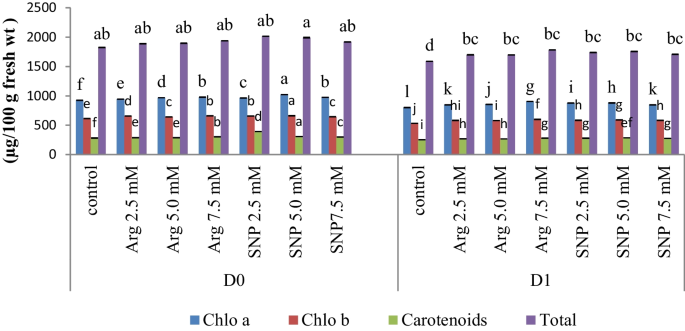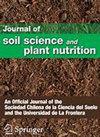田间条件下外源施用精氨酸和硝普钠诱导花生对干旱胁迫和麻孢子叶斑病的抗性
IF 3.1
3区 农林科学
引用次数: 0
摘要
自然地,在田间条件下,植物经常受到两种或两种以上胁迫因素的混合作用。干旱是一种主要的非生物胁迫,真菌病原体是植物面临的主要生物胁迫挑战,对植物的发育和生产力产生负面影响。研究表明,在花生叶片施用一氧化氮(NO)对诱导植物对生物和非生物胁迫的耐受性具有积极作用。本研究通过2021年和2022年两个连续生长季的大田试验,研究了在100%和75%灌溉需水量(WIR)两种灌溉水平下,一氧化氮(NO)供体、硝普钠(SNP)和精氨酸(Arg)(2.5、5.0和7.5 mM)对花生生长、部分生化指标、产量和品质的影响,以及对麻孢叶斑病的抗性诱导。灌水量的减少显著降低了植株的茎长、枝数、鲜干重、光合色素成分、内源吲哚乙酸(IAA)含量和产量成分。根系鲜重和干重、酚类物质、总可溶性糖(TSS)、脯氨酸含量、过氧化氢(h2o2)积累和过氧化脂质含量均显著增加。相反,叶面施用Arg和SNP可通过提高光合色素、IAA、酚类化合物、TSS和脯氨酸含量,缓解干旱对花生生长和生产力的负面影响。此外,SNP和Arg通过诱导抗氧化酶降低h2o2和脂质过氧化作用,显著降低氧化损伤。高浓度Arg和SNP处理显著降低了玉米叶斑病(CLS)的发病率。有趣的是,与其他处理相比,在胁迫和非胁迫植物中,7.5 mM SNP处理在降低发病率和严重程度方面最有效,而2.5 mM Arg处理的降低效果最低。综上所述,在花生叶片上处理SNP或Arg均可通过调控与光合和氧化反应相关的生理生化过程,对干旱胁迫和诱导花生对斑虫病的抗性产生深远影响。本文章由计算机程序翻译,如有差异,请以英文原文为准。

Induction of Tolerance in Groundnut Plants Against Drought Stress and Cercospora Leaf Spot Disease with Exogenous Application of Arginine and Sodium Nitroprusside Under Field Conditions
Abstract Naturally, under field conditions, plants are regularly experienced by a mixture of two or more stress factors. Drought is a major abiotic stress, and fungal pathogens characterize a main biotic stress challenge faced by plants and impact negatively on plant development and productivity. We propose that foliar application of nitric oxide (NO) donors can have positive effects on the induction of tolerance to biotic and abiotic stress on groundnut plants. This investigation was carried out to study the changes in growth, some biochemical aspects, and yield and quality of groundnut plants as well as induction of resistance to Cercospora leaf spot disease in response to nitric oxide (NO) donors, sodium nitroprusside (SNP), and arginine (Arg) (2.5, 5.0, and 7.5 mM) under two water irrigation levels 100% and 75% of water irrigation requirements (WIR), in two field experiments through two successive growing seasons of 2021 and 2022. Decreasing irrigation water significantly reduced shoot length, branches numberplant -1 , shoot fresh and dry weight, photosynthetic pigments components, endogenous indole acetic acid (IAA) contents, and yield components. Furthermore, root fresh and dry weight, phenols, total soluble sugars (TSS), proline contents, and the accumulation of hydrogen peroxide (H 2 O 2 ) and lipid peroxidation of groundnut leaves increased significantly. Contrarily, foliar application with Arg and SNP alleviated the negative influences of drought on growth and productivity of groundnut plants via enhancing photosynthetic pigments, IAA, phenolic compounds, TSS, and proline contents. Additionally, SNP and Arg significantly decreased oxidative damage through decreasing H 2 O 2 and lipid peroxidation by the induction of antioxidant enzymes. Remarkably, the increase of drought level led to a reduction in Cercospora leaf spot (CLS) disease with the use of high concentrations of both Arg and SNP. Interestingly, in both stressed and unstressed plants, SNP treatment at 7.5 mM was the most effective in reducing the incidence and severity of disease, while Arg at 2.5 mM recorded the lowest reduction compared to other treatments. In conclusion, foliar treatment of either SNP or Arg is a profound effect on modulating the drought stress and induction of resistance to Cercospora leaf spot disease of groundnut plants throughout regulating physiological and biochemical processes associated with photosynthesis and oxidative responses.
求助全文
通过发布文献求助,成功后即可免费获取论文全文。
去求助
来源期刊

Journal of Soil Science and Plant Nutrition
SOIL SCIENCE-
自引率
10.30%
发文量
331
期刊介绍:
The Journal of Soil Science and Plant Nutrition is an international, peer reviewed journal devoted to publishing original research findings in the areas of soil science, plant nutrition, agriculture and environmental science.
Soil sciences submissions may cover physics, chemistry, biology, microbiology, mineralogy, ecology, pedology, soil classification and amelioration.
Plant nutrition and agriculture submissions may include plant production, physiology and metabolism of plants, plant ecology, diversity and sustainability of agricultural systems, organic and inorganic fertilization in relation to their impact on yields, quality of plants and ecological systems, and agroecosystems studies.
Submissions covering soil degradation, environmental pollution, nature conservation, and environmental protection are also welcome.
The journal considers for publication original research articles, technical notes, short communication, and reviews (both voluntary and by invitation), and letters to the editor.
 求助内容:
求助内容: 应助结果提醒方式:
应助结果提醒方式:


